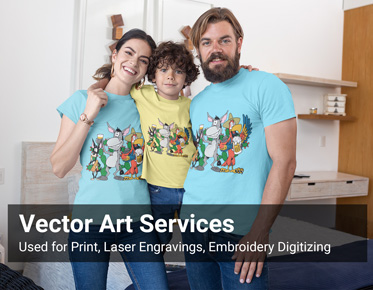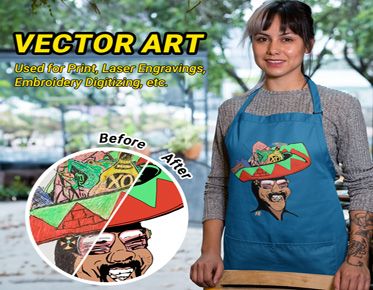The Ultimate Guide to Screen Printing/Eagle Digitizing
Screen printing is an art form that has stood the test of time.
It combines creativity with technique to produce stunning designs on a variety
of surfaces. Whether you're a beginner or a seasoned pro, there's always
something new to learn in the world of screen printing. Read here are some things that you should know
when it comes to vector file conversion!
The
Basics of Screen Printing
What Exactly is Screen Printing?
Screen printing is a printing technique that uses a mesh screen to
transfer ink onto a substrate, except in areas made impermeable to the ink by a
blocking stencil. It's a versatile method used to print on textiles, paper,
wood, and more.
Why Screen Printing is So
Popular
Screen printing is beloved for its ability to produce vibrant colors
and long-lasting designs. It's highly customizable, making it a go-to for
artists, fashion designers, and businesses alike. The tactile quality of screen
prints also adds to its appeal, giving products a unique, handmade feel.
A
Brief History of Screen Printing
The Origins of Screen Printing
Screen printing traces its roots back to ancient China, around the Song
Dynasty (960–1279 AD). It spread to other Asian countries like Japan, where it
was refined and adapted for printing on fabric and paper.
Screen Printing Through the Ages
In the 18th century, screen printing made its way to Europe, where it
was initially used for wallpaper and fabric printing. The technique evolved
significantly in the 20th century with the advent of new materials and
technologies, making it more accessible and efficient.
Modern Advancements in Screen
Printing
Today, screen printing benefits from advancements such as automated presses, photo-reactive emulsions, and digital design tools. These innovations have streamlined the process, allowing for greater precision and consistency in prints.
The
Science Behind Screen Printing
How Screen Printing Works
At its core, screen printing involves creating a stencil (or screen),
applying ink through the screen onto the substrate, and then curing the ink to
make it permanent. Every color in the design requires a screen of its own.
The Role of Stencils and Screens
Stencils are crucial in screen printing as they define the areas where
ink will pass through. Screens, typically made of polyester mesh, hold the
stencil in place. The mesh count of the screen determines the level of detail
and the thickness of the ink application.
The Importance of Mesh Count
Mesh count refers to the number of threads per inch on the screen.
Higher mesh counts are used for detailed designs and finer inks, while lower
mesh counts are suitable for bold, thick ink applications. Choosing the right
mesh count is vital for achieving the desired print quality.
Essential
Tools and Materials
Screens: Types and Uses
Screens come in various sizes and mesh counts. Aluminum frames are
durable and ideal for high-volume printing, while wooden frames are more
affordable and suitable for beginners. The type of screen you choose will
depend on your project’s needs.
Inks: Choosing the Right Type
There are several types of screen printing inks, including plastisol,
water-based, and discharge inks. Plastisol inks are thick and vibrant, ideal
for textiles. Water-based inks are softer and environmentally friendly, while
discharge inks are used for soft, vintage-style prints.
Squeegees: Getting the Perfect
Print
Squeegees are used to push ink through the screen onto the substrate.
They come in various shapes and sizes, with different blade materials like
rubber or polyurethane. The right squeegee ensures an even application of ink.
Emulsions and Exposure Units
Emulsions are light-sensitive coatings applied to screens to create
stencils. Exposure units use UV light to harden the emulsion, forming the
stencil. Proper exposure ensures sharp, detailed designs
Step-by-Step
Screen Printing Process
Designing Your Artwork
Start with a design that can be easily separated into individual
colors. Use graphic design software to create clean, vector images.
Preparing the Screen
Coat the screen with emulsion in a dark room to prevent premature
exposure to light.
Applying Emulsion
Apply an even coat of emulsion to both sides of the screen using a
scoop coater. Allow it to dry in complete darkness.
Exposing the Screen
Place your design (printed on a transparent film) onto the screen and
expose it to UV light. The light hardens the emulsion except where it is
blocked by the pattern.
Washing Out the Design
Rinse the screen with water to wash away the unhardened emulsion,
revealing your stencil.
Setting Up the Print
Secure the screen on your printing press and align it with your
substrate.
Printing the Design
Apply ink to the screen and use a squeegee to press it through the
stencil onto the substrate. Repeat for each color in your design.
Curing the Ink
Dry the printed design using a heat press or conveyor dryer to cure
the ink, ensuring it’s set and durable.
Techniques
and Styles in Screen Printing
Spot Color Printing
Spot color printing uses solid blocks of color, making it ideal for
bold, graphic designs.
Halftone Printing
Halftone printing uses dots of varying sizes to create gradients and
shades, simulating continuous tones.
Grayscale Printing
Grayscale printing uses different shades of gray to reproduce
monochromatic images.
Duotone Printing
Duotone printing involves using two colors to create a rich, layered
effect.
Simulated Process Printing
Simulated process printing mimics the look of full-color images using
a limited color palette and halftones.
Four-Color Process Printing
Four-color process printing, or CMYK printing, uses cyan, magenta,
yellow, and black to produce full-color images.
Common
Applications of Screen Printing
T-Shirts and Apparel
Screen printing is widely used for customizing t-shirts, hoodies, and
other apparel due to its durability and vibrant colors.
Posters and Art Prints
Artists use screen printing to create limited edition art prints and
posters, valued for their texture and quality.
Packaging and Labels
Screen printing is employed in packaging and label printing for its
ability to produce sharp, eye-catching designs.
Signage and Banners
Screen printing is ideal for outdoor signage and banners, offering
weather-resistant and long-lasting prints.
Screen
Printing on Different Materials
Printing on Fabric
Screen printing on fabric is the most common application, offering
vibrant and durable prints on various textiles.
Printing on Paper
Paper printing is used for posters, business cards, and art prints,
providing a high-quality, tactile finish.
Printing on Plastic and Metal
Special inks and techniques allow for printing on non-porous surfaces
like plastic and metal, expanding the range of applications.
Specialty Materials
Screen printing can also be done on wood, glass, and ceramics,
requiring specific inks and techniques to ensure adhesion and durability.
Advantages
of Screen Printing
Durability and Longevity
Screen prints are known for their durability, resisting fading and
washing out over time.
Versatility in Design
The technique can be used on a wide range of materials and for both
simple and complex designs.
Vibrant and Opaque Colors
Screen printing produces bright, opaque colors that stand out on both
light and dark backgrounds.
Limitations
of Screen Printing
Setup Costs and Time
Initial setup for screen printing can be time-consuming and costly,
particularly for multi-color designs.
Limited to Fewer Colors
Each color requires a separate screen, making the process less
efficient for designs with many colors.
Complexity with Detailed Designs
Highly detailed or photorealistic designs can be challenging to
reproduce accurately with screen printing.
Comparing
Screen Printing to Other Printing Methods
Screen Printing vs. Digital
Printing
Screen printing offers more durable prints and better color vibrancy,
while digital printing is faster and more cost-effective for short runs.
Screen Printing vs. Heat
Transfer
Heat transfer is easier for beginners and better for complex designs,
but screen printing produces more durable and higher-quality prints.
Screen Printing vs. Sublimation
Sublimation is great for detailed, full-color prints on synthetic
materials, but screen printing is more versatile in terms of materials and
finishes.
Common
Challenges and How to Overcome Them
Dealing with Ink Bleeds
Ink bleeds can be prevented by using the correct mesh count and proper
squeegee technique. Ensure screens are properly tensioned and ink is applied
evenly.
Preventing Screen Clogging
Clean screens thoroughly after each use and store them properly to
avoid clogging. Use appropriate cleaners and avoid leaving ink to dry on the
screen.
Ensuring Consistent Prints
Consistency can be achieved by maintaining uniform screen tension,
using high-quality materials, and following a standardized printing process.
Maintenance
and Care for Screen Printing Equipment
Cleaning Your Screens
Clean screens immediately after use to prevent ink from drying and
clogging the mesh. Use the proper cleaning solutions and techniques to
guarantee a thorough cleaning.
Proper Storage for Longevity
Store screens and tools in a dry, dust-free environment. Protect
screens from light and physical damage to prolong their lifespan.
Regular Maintenance Tips
To ensure peak performance, inspect and maintain your equipment on a
regular basis. Replace worn-out components and follow manufacturer guidelines
for care and maintenance.
Eco-Friendly
Practices in Screen Printing
Sustainable Inks and Materials
Opt for water-based and eco-friendly inks that have lower
environmental impact. Use biodegradable emulsions and cleaners to minimize
chemical waste.
Reducing Waste in the Printing
Process
Plan your prints to minimize waste, recycle screens, and reuse materials
where possible. Implement efficient printing practices to reduce excess ink and
material usage.
Eco-Friendly Brands and Products
Support brands that prioritize sustainability and offer eco-friendly
products. Look for certifications and environmental commitments from suppliers.
Popular
Screen Printing Brands and Supplies
Top Brands in the Industry
Brands like Speedball, Ryonet, and Ecotex are well-known for their
quality screen printing supplies and equipment. They offer a wide range of
products suitable for different skill levels and project types.
Best Places to Buy Screen
Printing Supplies
Online retailers, specialty art stores, and direct manufacturers are
good sources for screen printing supplies. Compare expenses, read reviews, and
ask about warranties and return policies.
Customer Reviews and
Recommendations
Read customer reviews and recommendations to find reliable products and brands. Join screen printing communities to get firsthand advice and tips from experienced printers. Additionally, Eagle Digitizing offers vector conversion services that can significantly enhance the quality and precision of your screen printing projects.
Screen printing is a versatile and rewarding craft that combines
creativity with technical skill. Whether you're a hobbyist or a professional,
the right tools and techniques can help you achieve stunning results. With
Eagle Digitizing's vector conversion services,
you can ensure your designs are optimized for the best possible outcome.
Investing time in learning and perfecting screen printing can open up numerous
creative possibilities. Stay curious, keep experimenting, and enjoy the process
of bringing your designs to life.



